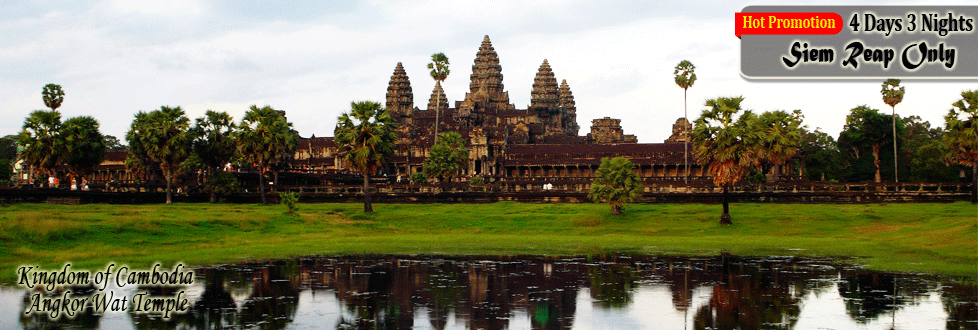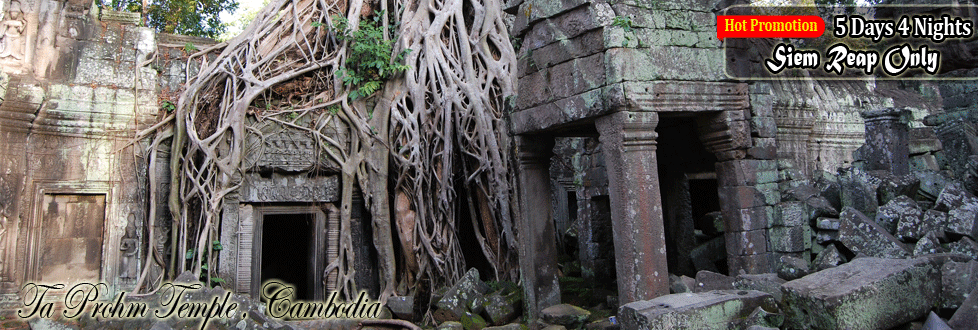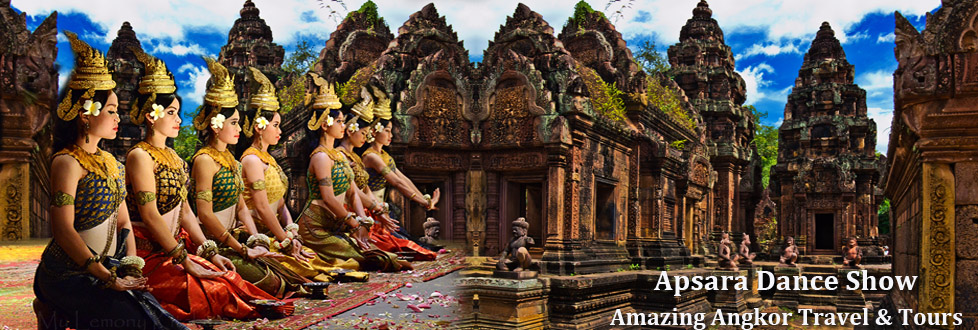What type of clothes/shoes are good for site seeing? Answer: Yes, the clothes for sightseeing temples and palace here should be normal clothes but should not wear short shirt or short pant and T-shirt or shirt should cover shoulders
Sampot

 Apsara dressed in Angkorian-style sampot cloth. The sampot is the national garment of Cambodia. The traditional dress is similar to those worn in the neighboring countries of Laos and Thailand, but variations do exist between the countries. The sampot dates back to the Funan era when a Cambodian king allegedly ordered the people of his kingdom to wear the sampot at the request of Chinese envoys. There are many variations for the sampot, each is washed according to social class. The typical sampot, known also as the sarong is typically worn by men and women of lower class. It measures approximately one and a half meters and both ends are sewn together. It is tied to safely secure it on the waist.
Apsara dressed in Angkorian-style sampot cloth. The sampot is the national garment of Cambodia. The traditional dress is similar to those worn in the neighboring countries of Laos and Thailand, but variations do exist between the countries. The sampot dates back to the Funan era when a Cambodian king allegedly ordered the people of his kingdom to wear the sampot at the request of Chinese envoys. There are many variations for the sampot, each is washed according to social class. The typical sampot, known also as the sarong is typically worn by men and women of lower class. It measures approximately one and a half meters and both ends are sewn together. It is tied to safely secure it on the waist.
Sampot Chang Kben
 Sampot Chang Kben is the preferred choice of clothing for women of upper and middle classes for daily wear. This practice of daily wear died out in the beginning of the twentieth century. Unlike the typical Sampot, it is more of a pant than a skirt. It is a rectangular piece of cloth measuring 3 metres long and one metres wide.[2] It is worn by wrapping it around the waist, stretching it away from the body and twisting the knot. The knot is then pulled between the legs and held by a metal belt. Regardless of class, all Cambodian women wear the Sampot Chang Kben on special events. Men may also wear it, but the traditional patterns depend on gender. The Sampot Chang Kben is adopted in Thailand and Laos, where it is known as Chong Kraben. It dates to the to ancient Cambodia where deities often wore such styles.
Sampot Chang Kben is the preferred choice of clothing for women of upper and middle classes for daily wear. This practice of daily wear died out in the beginning of the twentieth century. Unlike the typical Sampot, it is more of a pant than a skirt. It is a rectangular piece of cloth measuring 3 metres long and one metres wide.[2] It is worn by wrapping it around the waist, stretching it away from the body and twisting the knot. The knot is then pulled between the legs and held by a metal belt. Regardless of class, all Cambodian women wear the Sampot Chang Kben on special events. Men may also wear it, but the traditional patterns depend on gender. The Sampot Chang Kben is adopted in Thailand and Laos, where it is known as Chong Kraben. It dates to the to ancient Cambodia where deities often wore such styles.
Sampot Phamuong
Sampot Phamuong are many different variation of traditional Khmer textiles.[4] They are single colored and twill woven. There are currently 52 colors used in Sampot Phamuong. The Phamuong Chorabap is a luxurious fabric using up to 22 needles to create. Phamuong variation are rabak, chorcung, anlounh, kaneiv and bantok. It usually contains floral and geometrical motifs. The most valued silk used to create the Phamuong is Cambodian yellow silk, known for its fine quality. New designs draw inspiration from ancient patterns of old silk.
Sampot Hol
Sampot Hol is a typical traditional textile. There are two kinds of Sampot Hol, one is a wrapping skirt that uses a technique called chong kiet and twill weave. Influenced by the Indian patola, it developed patterns and techniques over the centuries to become a genuine Khmer art style. The sampot hol has over 200 patterns combined with three to five colors, yellow, red, brown, blue, and green. There are four variations, sampot hol, sampot hol por, sampot hol kben and sampot hol ktong. Patterns are usually geometric motifs, animals, and flower motifs.
Both Sampot Phamuong and Sampot Hol believed to have invented from original Sampot in Oudok Era as word Phamuong comes from Siam language that Pha mean Fabric and Mung mean violet while Sampot Hol had introduced as ceremonial skirtcloth to the Thai court as sompak poom or pha poom in 19th century.[5][6] Although that era, Thai culture influenced that much into Khmer society, Khmer weaving however, is not a copy from Siam, because Cambodia already had a weaving culture before the Klung civilization. At this time, Cambodia still do not know what the word like Phamung meant in that time.
Sampot Tep Apsara
Sampot Tep apsara Angkor is famous sampot in Khmer empire era, which still found on the bas belief of Apsaras carving aroung Khmer Famous temple, Angkor wat. Generally, all of thoes skirt had tied to safely secure it on the waist with their style of golden belt, drop a long pleat at the middle of Sampot which the length of that fabric recoil at the calf of the leg. The hem of skirt at the both part always get a small knot up. There are also two knots come from the waist of sampot with the left Knot is the long knot like the thin long fabric while the right Knot in the same pgysical appearance but more decortion at the middle of it knot. Today, this style of sampot become the fictional skirt for nowadays people as No of this kind of sampot wearing by anyone but will an illustration to public as it will wearing in some show as they disgus as Apsara.
Sampot Samloy
Sampot Samloy is long skirt used daily for men and women. The name Samloy mostly refers to no colour but black for ancient name, now it is sometimes recognized as the soft, thin fabric with more decoration and pattern look Sarong Batik but may be smaller. With its thin and soft appearance, the style of dress had been required to hold a knot, make it to become Sampot Chang Kben easily. However, it is necessary to make a fold at the left or right side like Sarong and Another sampot but most of female wearer, likely to hold its knot at up middle, drop a small division site at the length of Saloy at the knee to be easily to walk for the wearer. Saloy was known to be popular during Chatomok Era.
Sampot Chorabap
Sampot Chorabap is a long skirt of silk embroidered all over the gold thread,, worn by woman in Khmer classical dance, newlywed and the character of Mae Hua (Khmer: ម��?​ហួ) in Royal Ploughing Ceremony of Cambodia.
Sampot Sang
Sampot Sang is a short skirt with silk embroidery.
Sampot Seai Sua
Sampot Seai Sua is a kind of skirt of one colour with a gold or silver embroidered band along a lower ham. roday, this skirt is very popular among Laotian's lady than Khmer people.
Sampot Lbak
Sampot Lbak is a long skirt covered with entirely silk embroiredy. Today it is worn in marriage ceremonies in the place like Sampot Sabum. In ancient times, This kind of sampot is mostly worn by Noblemen of Cambodia during Lovek era.
Sampot Aslom
Sampot Aslom is a long skirt with the vertical stripes, commonly worn by old people or farmer in the countryside. This one is share highly common to Burma's Longyi.
Tops
There are many variation of Tops known as Shirt in Cambodia. The invention of traditional Aor is found after Khmer empire era at the late of 13 century to 14 century
Chang Pok
Chang Pok is a piece of fabric in any colour which Khmer people at the late of 13 century especially women, started used it to cover their chest, showed up only the stomach. The style of Covering, is cover it at the back and each side of the fabric to join at the middle the chest and roll it to up to be smaller to tie which this style called Chang Pok.It then developed more to Tronum which is a thick and strong fabric cover on the chest of khmer lady, which stick on the body strongly. Sometimes, the commonly style of wearing this garment is similar way to wearing Aor Chang Pok, just Aor tronum, not showed as much skin like Aor Chang Pok. Popularity of wearing Aor Tronum, were for young rich lady during Chatomok Era and today an important costume of all to be used in Khmer classical dance.
Av Bupong
Av Bupong mean tube skirt in English according to appearance like a long tube, bribe to the body at the head and drop to down easily. Aor Bupok is a long shirt like a dress than the regular shurt similar to Vietnamese Ao Dai, Indian's Kurta and Malaysia's baju kurung. Generally, It has a Collar with a button at the length from the neck to chest like Kurta while it normally norrow at the middle of the shirt in the stomach part like Baju Kurung but has the small hidden cut at hem of each shirt of shirt like Ao Dai which allowed the below part of shirt turn to Wide and Big. Most of Shirt is length at the knee while few one just only Length at the thigh. This Shirt is famous during Lovek to Oudong era worn by rich lady.
Av Dai Puon
Av Dai Puon is a traditional blouse in Lovek era. The name of dai puon is literally meaning according to inflated short arm. This shirt usually had a row of button and just of few of extremely rich girl counld had one during that era.
Av Pnot Kback
Av Pnot Kback is the female formal shirt used for rich young lady. The whole row of its pleat filled with the decoration of flower paird with the collar and the hem of arm in the same style. This shirt invention period is not specifics but most of people believed it going to Lovek. This one is quiet similar to Burma one, as maybe one of least inflnuced of Burma culture.
Av Neang Nov
Av neang nov is a the long arm shirt, worn by woman.
Av Bar Bov
Av Bar Bov is a no arm coat wear on the Av neang nov and Av Dai Puon. This shirt had the dounble of Button on its pleat. The name of Av Bar Bov is known as Lotus leaves, the literally meaning from Thailand.
Av Pak
Av Pak is a recent popular fashion blouse in Cambodia worn by Woman. This one is known as the khmer version of Kebaya with plain stamped cotton elaborately hand-painted embroidered silk with gold thread. In the past, this kind of shirt required it own unique style with only white colour with the high full of embroider. Today, This shirt has the more gold thread in several colour and had cut into a lot of modern fashion which highly popular to Khmer people especially middle aged and young woman with the narrow style and several decoration model. This shirt had been noted as today's khmer national costume where a lot of khmer girl had used this blouse at the special occasion both inside and outside Cambodia to revived the khmer identity. This shirt usually worn with Sampot Hol and a few worn with Sampot Chang Kben
Krama
Traditionally Cambodians wear a checkered scarf called a "Krama". The Krama has been a symbol of Cambodian dress since the first century reign of Preah Bath Hun Tean although it is not clear when exactly the krama became fashionable in the streets. A Cambodian woman wearing a conical hat to keep off the sun's heat in the rice fields. Her krama is worn underneath The "krama" is what distinctly separates the Khmer (Cambodians) from their Thai, Vietnamese, and Laotian neighbors. The scarf is used for many purposes including for style, protection from the hot sun, an aid (for your feet) when climbing trees, a hammock for infants, a towel, or a "sarong". A "krama" can also be easily shaped into a small child's doll for play. Under the Khmer Rouge, all Khmer were forced to wear a checkered "krama". The conical hat is also worn by many particularly by workers in the countryside to keep the sun off. This, however, is a Vietnamese hat that has been adopted to a certain extent by Khmer in the provinces adjacent to Vietnam.




.jpg)
.jpg)
.jpg)

.jpg)
.jpg)
.jpg)

.gif)

 Cambodia Visa & Passport
Cambodia Visa & Passport 



 Apsara dressed in Angkorian-style sampot cloth. The sampot is the national garment of Cambodia. The traditional dress is similar to those worn in the neighboring countries of Laos and Thailand, but variations do exist between the countries. The sampot dates back to the Funan era when a Cambodian king allegedly ordered the people of his kingdom to wear the sampot at the request of Chinese envoys. There are many variations for the sampot, each is washed according to social class. The typical sampot, known also as the sarong is typically worn by men and women of lower class. It measures approximately one and a half meters and both ends are sewn together. It is tied to safely secure it on the waist.
Apsara dressed in Angkorian-style sampot cloth. The sampot is the national garment of Cambodia. The traditional dress is similar to those worn in the neighboring countries of Laos and Thailand, but variations do exist between the countries. The sampot dates back to the Funan era when a Cambodian king allegedly ordered the people of his kingdom to wear the sampot at the request of Chinese envoys. There are many variations for the sampot, each is washed according to social class. The typical sampot, known also as the sarong is typically worn by men and women of lower class. It measures approximately one and a half meters and both ends are sewn together. It is tied to safely secure it on the waist.  Sampot Chang Kben is the preferred choice of clothing for women of upper and middle classes for daily wear. This practice of daily wear died out in the beginning of the twentieth century. Unlike the typical Sampot, it is more of a pant than a skirt. It is a rectangular piece of cloth measuring 3 metres long and one metres wide.[2] It is worn by wrapping it around the waist, stretching it away from the body and twisting the knot. The knot is then pulled between the legs and held by a metal belt. Regardless of class, all Cambodian women wear the Sampot Chang Kben on special events. Men may also wear it, but the traditional patterns depend on gender. The Sampot Chang Kben is adopted in Thailand and Laos, where it is known as Chong Kraben. It dates to the to ancient Cambodia where deities often wore such styles.
Sampot Chang Kben is the preferred choice of clothing for women of upper and middle classes for daily wear. This practice of daily wear died out in the beginning of the twentieth century. Unlike the typical Sampot, it is more of a pant than a skirt. It is a rectangular piece of cloth measuring 3 metres long and one metres wide.[2] It is worn by wrapping it around the waist, stretching it away from the body and twisting the knot. The knot is then pulled between the legs and held by a metal belt. Regardless of class, all Cambodian women wear the Sampot Chang Kben on special events. Men may also wear it, but the traditional patterns depend on gender. The Sampot Chang Kben is adopted in Thailand and Laos, where it is known as Chong Kraben. It dates to the to ancient Cambodia where deities often wore such styles. .png)
